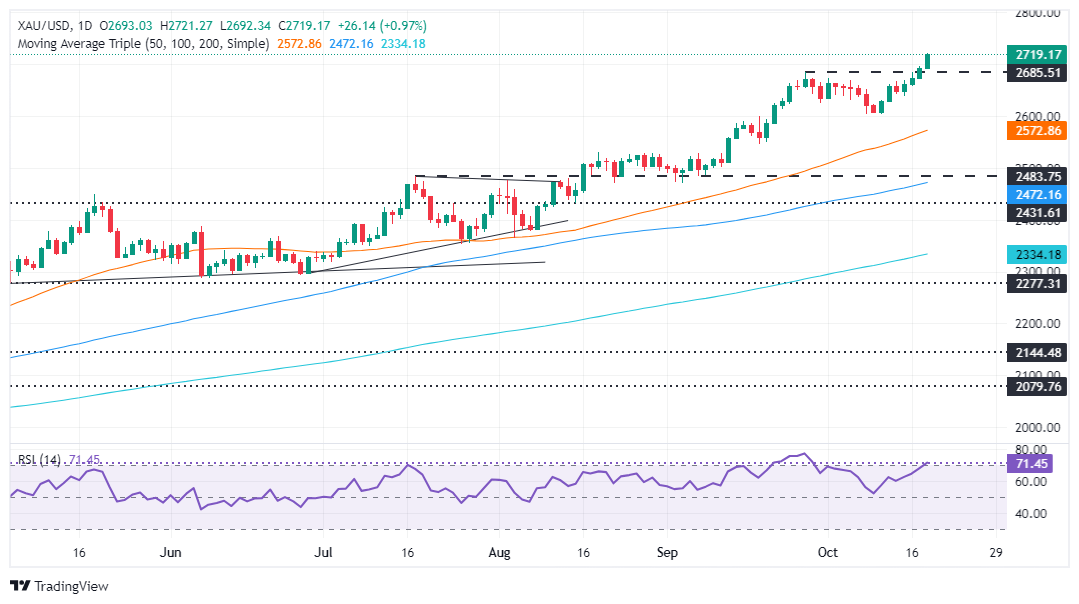Gold hits all-time highs on concerns about Middle East, US elections

- Gold rises 0.98%, reaching $2,720 as geopolitical tensions and US election concerns drive demand for safe-haven assets.
- Falling US Treasury yields and the weakening US Dollar further boost Bullion prices, with the US Dollar Index dropping to 103.45.
- Analysts predict continued Gold gains with Citi’s Max Layton forecasting prices could reach $3,000 an ounce within 6-12 months.
Gold prices continued to print record highs after breaching the $2,700 figure amid uncertainty surrounding the US election and tensions in the Middle East. This weighed on US Treasury bond yields and the Greenback, which tumbled to a two-day low of 103.45 after hitting a two-month peak of 103.87. At the time of writing, the XAU/USD trades at $2,721, up by 1.09%.
The market mood remains upbeat as Wall Street registers modest gains. In the meantime, geopolitics took center stage after Israel confirmed the death of Hamas leader Yahya Sinwar. Meanwhile, Hezbollah said that it is escalating its confrontation with Israel as US Defense Secretary Austin commented that the death of the Hamas leader could provide an opportunity for a ceasefire.
According to Kann News, US Secretary of State Antony Blinken told Israel’s President Isaac Herzog that he’s expected to arrive in the coming days to discuss a ceasefire deal.
Bullion prices extended their gains following Hezbollah’s threat to escalate the conflict. The XAU/USD rose sharply above $2,700 and reached an all-time high of $2,720.
Alexander Zumpfe, a precious metals trader at Heraeus Metals Germany, commented that, in addition to geopolitics, “Concerns around the U.S. presidential election and anticipation of looser monetary policies have further fueled the rally.”
Major central banks are expected to continue to ease policy. During the week, inflation in the UK in September was higher than the Bank of England’s (BoE) 2% target and came at 1.7% YoY, sparking speculation on a BoE rate cut. Yesterday, the European Central Bank (ECB) lowered borrowing costs after inflation dropped to 1.7%, beneath the ECB’s goal.
Consequently, global yields tumbled, a tailwind for the non-yielding metal. The US 10-year Treasury note yield has fallen two basis points (bps) during the day and is at 4.073% after hitting a weekly high of 4.142%.
Gold has hit multiple all-time highs during the year and is up by 30% YTD. Max Layton, Global Head of Commodities Research at Citi, foresees Gold reaching $3,000 an ounce over the next six to 12 months.
Despite that, the Fed is heavily expected to lower interest rates by 25 basis points at the November meeting. Odds remained at 92.9%, according to CME FedWatch Tool data.
Daily digest market movers: Gold price climbs, ignoring upbeat US data
- US Building Permits in September fell by 2.9%, decreasing from 1.47 million to 1.428 million, missing estimates of 1.46 million.
- Housing Starts for September dipped by -0.6%, from 1.361 million to 1.354 million.
- Data from the Chicago Board of Trade, based on the December fed funds rate futures contract, indicates that investors estimate 48 basis points (bps) of Fed easing by the end of the year.
XAU/USD technical outlook: Gold price surges above $2,700, eyes on $2,750
Gold price rally remains intact. Momentum backs bulls as depicted by the Relative Strength Index (RSI), soared and turned overbought, though with no signs of consolidating.
Given the backdrop, the path of least resistance is upward. Gold’s first resistance would be $2,750, followed by $2,800.
Conversely, if XAU/USD retreats from record highs below $2,700, it could pave the way for a pullback. The first support would be the October 17 high at $2,696, followed by the October 4 high at $2,670.
Gold FAQs
Gold has played a key role in human’s history as it has been widely used as a store of value and medium of exchange. Currently, apart from its shine and usage for jewelry, the precious metal is widely seen as a safe-haven asset, meaning that it is considered a good investment during turbulent times. Gold is also widely seen as a hedge against inflation and against depreciating currencies as it doesn’t rely on any specific issuer or government.
Central banks are the biggest Gold holders. In their aim to support their currencies in turbulent times, central banks tend to diversify their reserves and buy Gold to improve the perceived strength of the economy and the currency. High Gold reserves can be a source of trust for a country’s solvency. Central banks added 1,136 tonnes of Gold worth around $70 billion to their reserves in 2022, according to data from the World Gold Council. This is the highest yearly purchase since records began. Central banks from emerging economies such as China, India and Turkey are quickly increasing their Gold reserves.
Gold has an inverse correlation with the US Dollar and US Treasuries, which are both major reserve and safe-haven assets. When the Dollar depreciates, Gold tends to rise, enabling investors and central banks to diversify their assets in turbulent times. Gold is also inversely correlated with risk assets. A rally in the stock market tends to weaken Gold price, while sell-offs in riskier markets tend to favor the precious metal.
The price can move due to a wide range of factors. Geopolitical instability or fears of a deep recession can quickly make Gold price escalate due to its safe-haven status. As a yield-less asset, Gold tends to rise with lower interest rates, while higher cost of money usually weighs down on the yellow metal. Still, most moves depend on how the US Dollar (USD) behaves as the asset is priced in dollars (XAU/USD). A strong Dollar tends to keep the price of Gold controlled, whereas a weaker Dollar is likely to push Gold prices up.
Information on these pages contains forward-looking statements that involve risks and uncertainties. Markets and instruments profiled on this page are for informational purposes only and should not in any way come across as a recommendation to buy or sell in these assets. You should do your own thorough research before making any investment decisions. FXStreet does not in any way guarantee that this information is free from mistakes, errors, or material misstatements. It also does not guarantee that this information is of a timely nature. Investing in Open Markets involves a great deal of risk, including the loss of all or a portion of your investment, as well as emotional distress. All risks, losses and costs associated with investing, including total loss of principal, are your responsibility. The views and opinions expressed in this article are those of the authors and do not necessarily reflect the official policy or position of FXStreet nor its advertisers. The author will not be held responsible for information that is found at the end of links posted on this page.
If not otherwise explicitly mentioned in the body of the article, at the time of writing, the author has no position in any stock mentioned in this article and no business relationship with any company mentioned. The author has not received compensation for writing this article, other than from FXStreet.
FXStreet and the author do not provide personalized recommendations. The author makes no representations as to the accuracy, completeness, or suitability of this information. FXStreet and the author will not be liable for any errors, omissions or any losses, injuries or damages arising from this information and its display or use. Errors and omissions excepted.
The author and FXStreet are not registered investment advisors and nothing in this article is intended to be investment advice.




